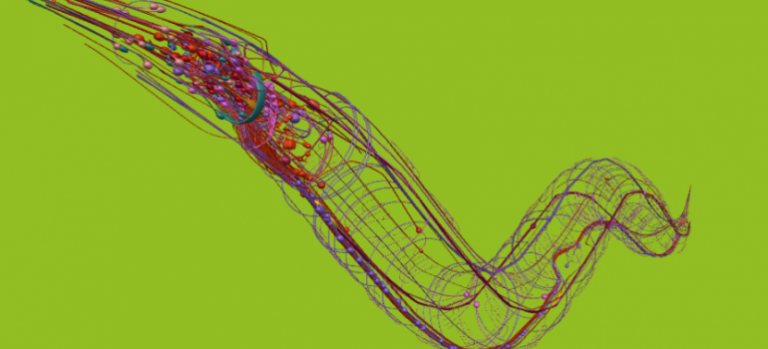

Neuron Specific Optogenetics (Photo: Behavioural Neurogenetics Lab)
When examining the small, round body of a one millimeter long worm known as the Caenorhabditis elegans, one has to wonder, what can humans learn from these simple creatures? The brilliance of using C. elegans in research is based on that fact alone, its simplicity. With the human brain containing billions of neurons and every neuron making 1,000 to 100,000 connections, it is impossible to examine the function of a single neuron on a cellular level. At least, in a human. C. elegans have only 302 neurons and fewer than 10,000 connections in its entire body.


Dr. Rankin analyzing data with a lab member
Dr. Catharine Rankin, Professor of Psychology in Behavioural Neuroscience, recognized the possibilities with these microscopic worms and made good use of the vast array of research already done on this worm. “Every single one of the 302 neurons has a name and we know what it connects to. I can try to understand what’s happening at the level of an individual neuron in this system,” says Rankin.
The big question in Dr. Rankin’s Behavioural Neurogenetics Lab is the effects of experience in the brain. Research has shown how different types of experience causes changes in neurons, and Dr. Rankin is particularly interested in adult learning and memory. One of the simplest forms of learning is habituation, or the act of gradually ceasing to respond to a repeated stimulus. Despite the simplicity of its concept, the effects of habituation on brain cells are largely unexplained. “Many famous learning theorists started with habituation, but moved on and ended up explaining something else.”
Dr. Rankin also is interested in the effects of either early deprivation or early enrichment and how that changes brain cells. “I have run a series of experiments to look at how early experience during development changes the nervous system.”
With research on C. elegans dating back to the 1970’s, a community has grown with a culture of sharing and building tools for each other to use. “If you look at the websites devoted to C. elegans, you will be stunned. There is so much information and background available.” Notable examples include the first sequenced genome and the only complete connectome – a neural wiring diagram of all the connections between neurons in an entire animal. With approximately 2,000 researchers around the world working on the same animal, there is a wealth of knowledge to be built on that is growing every day. “It allows basic cellular level questions to be addressed better than any other system.”


A Behavioural Neurogenetics Lab member
So what important questions can be answered by these worms? In Dr. Rankin’s work on habituation, her lab was the first to show that C. elegans can learn and remember, making her findings relevant to analyzing the processes that occur in humans under similar conditions. “I’m interested in habituation just for itself as a type of learning and memory, but also as a symptom of disease. A surprising number of psychiatric disorders have abnormal habituation as one of their symptoms. Habituation may be a way to diagnose how good synaptic connections are.” The possibility of understanding abnormal habituation in crippling psychiatric disorders such as schizophrenia, autism, Parkinson’s disease, and some forms of epilepsy may lead to future improvements in treatment. “Another thing I see is it might be helpful if you could divide patients with a disorder into subgroups that showed similar alteration in habituation curves. This might represent individuals with the same cause of the disorder and enhance our ability to diagnose and perhaps treat subgroups of individuals within the disorder.”
In simpler times, the measurement of the worm’s response was a slow, laborious task. “We used to do everything by hand, one worm at a time,” says Rankin. “The behaviour that we look at, I call the worms startle response. When the worm is startled it does a brief backwards movement. We measure the probability of it going backward, how long it goes backward for, and how fast it goes.” It is easy to imagine how time consuming it would be to have to find these measures manually. “Now we have a machine vision system that can score the behaviour of 50 to 100 worms at a time.” The multi-worm tracker is able to record a plate of worms and distinguish their forward and backward movements.
This information collected is displayed in graphs so researchers are able to study the habituation curve. In this response centered research observing habituation, the researchers had only been observing the backward movements of the worms. However, when a new use of the multi-worm tracker was discovered, more possibilities opened up. “What the multi-worm tracker has also allowed us to do is record everything they do in-between stimuli as well to see if learning changes that as well. It is a very novel way of learning. To not just look at the response itself but at all the other things it is doing.”
With the great overall discoveries made in the lab and new research prompts on the horizon, Dr. Rankin and her lab team find great pride and satisfaction in their work. “We love what we do. We’d like people to understand that there are different levels of understanding and there is real value in breaking things down to simple components in order to better understand them.”
-Samantha Yang



